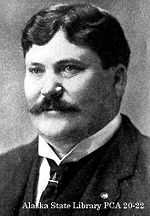Wilds P. Richardson

Wilds Preston Richardson (Hunt County, Texas, 20 March 1861– 20 May 1929) was an officer of the United States Army notable for being an explorer and geographer of Alaska in the early decades of the 20th century. During World War I he was promoted to the rank brigadier general and, because of his cold weather experience, sent to lead the Polar Bear Expedition, part of the Allied intervention in the Russian Civil War. Richardson retired after the war and died in Washington, D.C. in 1929.
Biography
Richardson was born on 20 March 1861 to Oliver P. and Hester F. (Wingo) Richardson in Hunt County, Texas. After attending schools in that county, the younger Richardson received an appointment to attend the United States Military Academy at West Point in 1880. After graduation in 1884, Richardson was commissioned as a second lieutenant in the 8th Cavalry Regiment, serving in California and other western posts. Richardson was promoted to first lieutenant in 1889, and joined the faculty at West Point three years later.
In 1897, Richardson was sent to Alaska to begin what would be a twenty-year stay. Initially in charge of scouting locations and supervising construction of military installations, in 1905 Richardson was appointed head of the War Department's Alaska Road Commission, which oversaw federal road construction projects in the territory. His major project was the completion of a 380-mile (610 km) road from Valdez to Fairbanks, later named the Richardson Highway in his honor.
After the entry of the United States into World War I, Richardson—promoted to brigadier general in August 1917—was assigned to command the 78th Infantry Brigade of the 39th Infantry Division at Camp Beauregard, Louisiana, in March 1918. Arriving at Brest, France, on 3 September 1918, Richardson's unit participated in the closing stages of the war. After the Armistice, General John J. Pershing assigned Richardson—because of his Alaskan cold-weather experience—to the Polar Bear Expedition in Murmansk. Returning to the U.S. in October 1919,[1] Richardson reverted to the rank of colonel and retired the following October.
Richardson lived the remainder of his years at the Army and Navy Club in Washington, D.C.; he died at Walter Reed Hospital on 20 May 1929 and was buried at West Point.
Legacy
The U.S. Army post established near Anchorage, Alaska, in 1940 was named Fort Richardson in his honor. The Valdez-Fairbanks Trail, surveyed under his supervision in 1904, was named the Richardson Trail to honor him. In World War II, the U.S. Navy transport ship General W. P. Richardson was named in his honor.
References
- ↑ "General say Reds killed 82 Yankees in Russia". Chicago Daily Tribune. 1919-10-16. p. 7.
- Wilds Preston Richardson from the Handbook of Texas Online